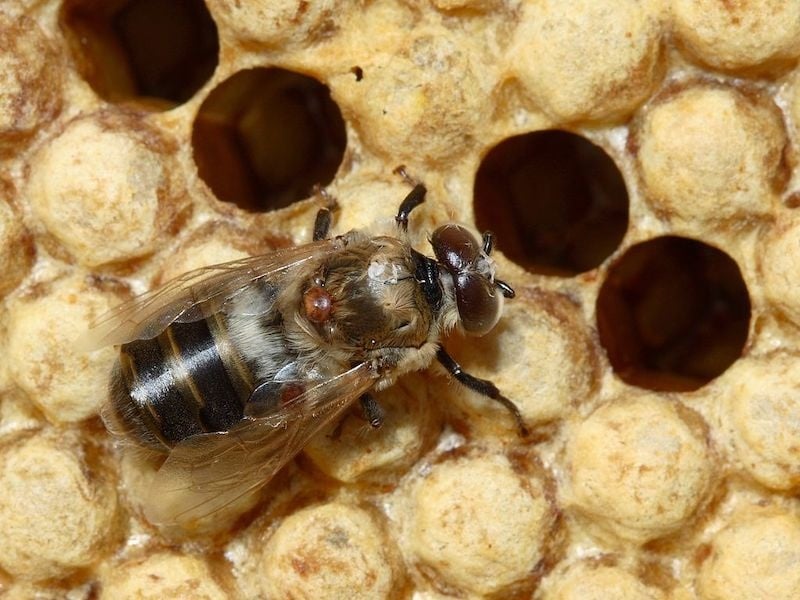How to do a Sugar Roll Test for Varroa Mites
- Posted on
- By Amber Shehan
- Posted in beekeeping, bees, hive, mite check, summer, varroa
- 0

Varroa mites are the number one threat to bee health. It is vital to stay on top of testing the infestation levels of every single one of your hives so that you can treat them and keep them alive.
Remember, it isn't a question of whether or not you have mites in your hives - it's a question of how big the mite infestation is.
One popular method for monitoring varroa is the sugar shake or sugar roll test. It is a non-lethal technique that shows how many mites are in a hive.
Did you know? Varroa populations can double in 30 days, and if left untreated, infected bee colonies can die within months.
How often do you test for Varroa mites?
It is wise to test your hives frequently, starting once it is warm enough to work them in early spring so that you can help support them as they begin to rebuild from winter. After that, you should test every hive once a month.
It is important to test for mites in late summer, so you can treat the hive before the cold season hits. An infected hive will struggle more than a healthy one to survive through winter.
Supplies: Build a Sugar Roll Kit
Here are the basic things you need to create a sugar shake test kit for your beekeeping supplies.
Sugar shake jar: At its most basic, this is a jar with a mesh strainer in the lid. The jar is for holding the sample of bees so they get coated in the sugar, and then shaking the mites out so they can be counted. You can make a shake jar with a wide-mouthed quart jar and 8-inch hardware cloth or use a tool like Varroa Easy Check.
10x Powdered sugar: Fill a plastic jar with powdered sugar and close it tightly. This makes the sugar easier to dispense and keeps it dry. The sugar makes the mites drop off of the bees and doesn't hurt the bees at all.
Half-cup measuring scoop: This is the perfect size to get a sample of 300 or so bees, which is standard for calculating the mite load.
Plastic tub: A dishwashing tub or small tote should suffice. You need something large enough to knock in a frame of bees to get your sample, plus it serves to hold your sugar roll kit for storage!
Water or White Paper: You need something to shake the mites and sugar into. Add about a half inch of water to your white tub, shake the jar into it, and then count the floating mites.
How to perform a sugar roll test
Gather your sugar roll kit, your regular beekeeping supplies, and suit up! You'll also want a smoker ready to go.
When you pull bees for your sample, you'll want to collect them from at least two central brood frames with older, open brood. Varroa mites live and reproduce within the brood chamber and are usually found on nurse bees and house bees.
When you pull a frame, check it carefully to ensure the Queen is not on it. You don't want to shake her into the sample!
Place your plastic tub on a firm surface and knock the frames into the bottom to dislodge the bees. Set the frames aside for a moment. Lift the tub and gently tap the bees into one corner. The forager bees will fly away, but the nurse bees remain in the tub.
Scoop up one-half cup of bees and put them in the empty sugar shake jar. Close the lid. Add approximately two tablespoons of powdered sugar through the mesh lid and sprinkle it onto the bees.
Next, shake the jar full of bees and sugar vigorously for one minute. This step is important, as it coats the bees in the sugar and makes the mites fall off. Set the bee-filled jar in the shade for at least two minutes while you reassemble the hive and dump the nurse bees back in.
Grab your tub and pour in at least a half-inch of water. Then vigorously shake the sugar and mites into the water for about a minute. Return the bees to the colony, where they will get cleaned off by the rest of their hive.
Count the reddish brown mites floating on the surface of the water, then calculate your mite load. Take the number of mites and divide it by three hundred (the number of bees in the sample), then multiply it by 100 to yield a percentage.
For example, 24 mites divided by 300 = 0.08. 0.08 x 100=8, or an 8% mite load.
Any mite level over 2-3% means that your hive should be treated. There are many treatment options, and choosing the right one can be tricky. It is best to consult with other beekeepers in your area and do your research before using any mite treatment products. You can always call the store to ask for help with choosing the right option.
We often invite Lewis Cauble, our North Carolina state bee inspector to join our team at Honey & The Hive to do a free sugar roll demo - check our class schedules for more! He’ll be here on August 12, 2023 from 11-12pm - we hope to see y'all there.
Watch a video from 2020 featuring Sarah McKinney and Lewis Cauble performing a sugar roll demonstration:
References & Resources:
Mite-Check Survey & App:
https://research.beeinformed.org/mitecheck/
Honey Bee Health Coalition - Free Varroa Resources: https://honeybeehealthcoalition.org/resources/varroa-management/
The Honey Bee Health Coalition Guide to Varroa Management PDF:

Comments
Be the first to comment...